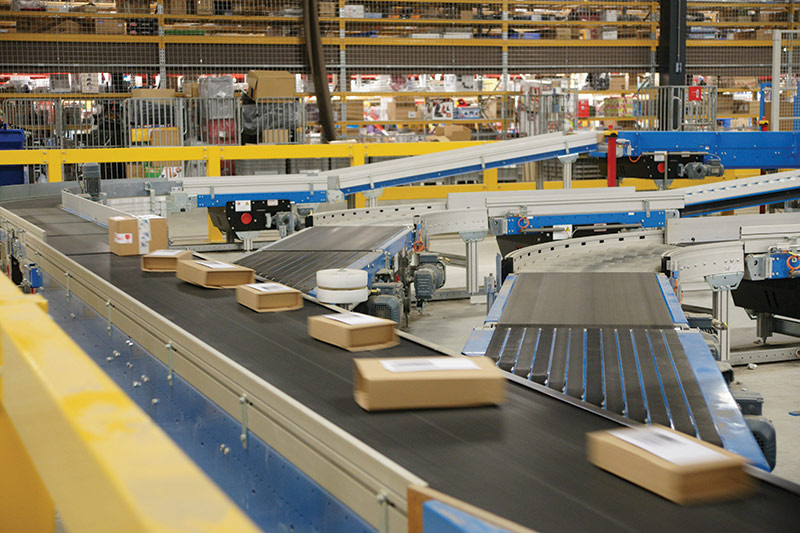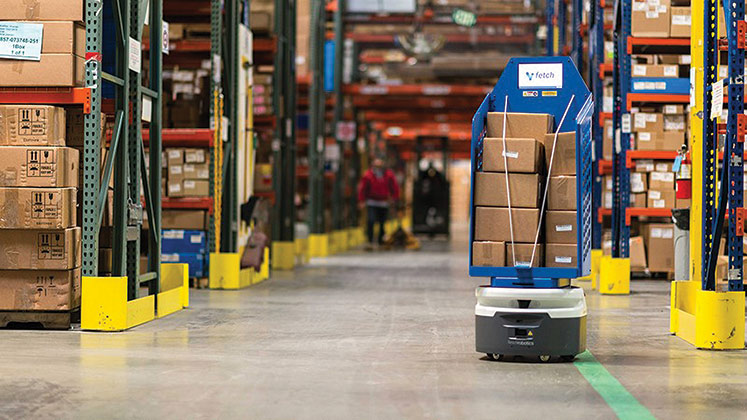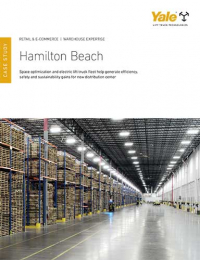Omni-channel of the future
It’s all about inventory and the consumer as retailers struggle to find the right balance of philosophy, operations and technology.

If there was ever a full court press in retail, this is it.
Supply chain disruptions for 18 months or more. Inventory arriving after the season. Excessive inventories in the next cycle. A constant change in the mix of products. An oscillating combination of in-store and e-commerce traffic. Steady pressure on DCs to manage omni-channel to perfection. Plus, unique holiday seasons sandwiched in there.
Managing omni-channel retail has not been easy and won’t be going forward. After all, there’s also the matter of consumer expectations. Correction. That should read rising consumer expectations. They expect it all. Now. Or at most, in the next couple of hours. Even two-day delivery is not considered exemplary performance by a retailer anymore.
Are consumer expectations of retailers at least a little bit unreasonable or unrealistic? Probably.
Do consumers care? Certainly not. If you want to stop reading for a minute and go look in the mirror, please do.
Back in the early days of the pandemic, Amazon had some troubles meeting its pre-pandemic performance levels. And the conclusion of an industry pundit at the time was that those shortcomings most certainly cost Amazon significant market share. To whom, exactly?
Today, retailers are all in and all in on omni-channel simultaneously. There’s no retailer with a future that isn’t scanning the full court for the path to a buzzer beater.
Becoming “phygital”
Actually two players on the court matter most: One is inventory and the other is the consumer. Everything else flows from how those two interact. The idea is for it all to be seamless regardless of the channel, hence the omni-channel nomenclature.
As to inventory, the focus is on each individual unit of a SKU and where it sits at any given moment in the supply chain and through the order cycle all the way to returns. As to the consumer, it’s all about what the retailer knows about each one in advance of a purchase. Retail today is actually a game of matching up those two so the right inventory is in the right place when the consumer wants it.
But there’s a problem: Only 3% of U.S. retailers say they have an accurate overview of their inventory in stores and DCs 100% of the time, says Ann Ruckstuhl, chief marketing officer and senior vice president of Manhattan Associates. Her source is a survey Manhattan did about retail over 3,500 adults (including 750 retail professionals) in the United States and five European countries.

About consumers, he says this: “We have to understand each of our customers and treat them individually and appropriately. We have to give them a great experience in stores and on the Web, then get them their order promptly with great transparency.”
All of that sounds straightforward enough. But it’s not. Ruckstuhl says the story here is about recalibrating omni-channel.
Matt Guiste, retail industry leader at Zebra Technologies, identifies three stages to developing an omni-channel network. The three are philosophical, operational and technological.
He says, the philosophy of omni-channel has broad acceptance. But he estimates that retailers in general are only halfway down the path in terms of their operations and technologies.
Within the four walls, Diana Mueller, account executive at FORTNA, sees it this way: “Retailers in general can be grouped into two sets of extremes. Some are taking a holistic view of the DC and the future of automation. Others are focused on processes without much attention to automation. Instead, they will move to automation when the process warrants it.”
She goes on to explain that this process for retailers is not a few months and done. “There is no grand reveal. It’s much more like a daily exercise regimen. Retailers are on this path continually.”
Several experts here say far too many retailers think they don’t need much outside help on technology. They can solve it themselves. That is rarely the case according to consultants and technology suppliers.
Interestingly, Guiste doesn’t always use the term omni-channel. He also calls it “unified commerce.”
He says omni-channel is a narrow term for the collapsing of the online and in-store channels. But unified commerce is that plus a blending of digital and physical worlds for customers and retailers.
Or as Ruckstuhl says “shopping habits have changed forever as consumers have truly become ‘phygital.’”
What retailers are doing
It’s a tall order for retailers. And many different approaches are being tried. Consider these.
Sweetwater has a new West Coast DC. PacSun focuses on having the right inventory in the right places. Amazon, Shopify and others want to locate DCs for rapid order delivery and ease of managing returns.
Until just recently, Sweetwater, the world’s largest online retailer of musical instruments and pro audio equipment, filled orders from its Fort Wayne, Ind., DC. However, that was a problem for 25% of its customers that are on the West Coast. Delivering orders to them in less than two days just wasn’t possible, says Phil Rich, chief supply chain officer and senior vice president.
So, Sweetwater built a new 350,000-square-foot DC in Litchfield Park, Ariz. The new facility is more automated than the other, featuring conveyor, in-line scales and print-and-apply technologies.
Rich says even non-conveyables will be conveyable before long. And he expects robotics soon will be introduced to the facility, especially in the pick modules. Rich says the new DC will fulfill as much as 40% of the retailer’s business in time.
PacSun operates about 350 stores and three DCs, says co-CEO Relich. Focused on Gen-Z clothing, the retailer says about 65% of sales are at stores with 35% at the DCs for e-commerce. Relich also notes that about a quarter of those e-commerce orders are fulfilled by stores.
He goes on to say that stores this past summer shipped 40,000 items a day with an average of 1.5 items per order. That’s a notable accomplishment for a retailer that has shipped from stores only since the start of the pandemic.
As complicated as that mix is, Relich says it can be managed. PacSun uses a rules-based order management system (Manhattan Associates) and a third-party analytics expert with relatively strong results.
“We never have enough analytics,” says Relich. “But we’re investing. It’s a real challenge to manage inventory allocation to the stores. We have to have not just inventory but the right inventory in each store.”
He continues to point out that Gen-Z clothing is a very fast-moving market that does not repeat itself. So there’s one chance only to get inventory placement and quantity allocation right. That’s where the database of individual customers PacSun is building becomes so important. Never enough analytics, Relich reiterates. Got it.
Despite the comment earlier about retailers trying to do too much by themselves with technology, that doesn’t apply to Amazon, says Marc Wulfraat of MWPVL International. “Amazon’s roots are as a tech company not as a retailer. So they do not think like Walmart,” he says. But now Walmart and others are starting to think like Amazon.
Fulfillment by Amazon has been in place for a while. We all use it. But rarely do we think of it as what it really is— a third-party logistics provider, or a 3PL. Amazon’s innovation is now changing the game for Walmart, Target, American Eagle, Gap and Shopify, to name a few.
Wulfraat says retailers need to maximize their cash flow. And providing warehousing and transportation services for others can do just that. It’s a matter of offering full inventory management including product storage and handling as well as order fulfillment, packaging and shipping.
UPS’ Ware2Go has its own take on this niche, says Brian Gallagher, chief technology officer. It is an asset-light, software-as-a-service (SaS) platform for small and medium-sized retailers. “We help retailers make decisions about where and how to position inventory in more than 30 warehouses nationwide,” Gallagher says.
The idea is to get inventory as close as possible to consumers and have only one view into that inventory. Gallagher says machine learning is critical here, making decisions about what to buy, where to position it and then to ensure transportation and delivery are tailored to each order’s requirements. In the fourth quarter of last year, Ware2Go launched its beta of machine learning capabilities to make delivery date predictions for customers.
One last note about how Amazon is not standing still here. Mid-year, the company announced its program to develop item-picking robots. For some time now, the retailer has used its Kiva autonomous mobile robot technology to bring goods on shelves to pickers.
With the new picking robot, called Sparrow, so-called drive units deliver bins of items to a pick location. There, the robot will pick the required number of items. This is in the very early stages of a pilot, and humans are doing most of the picking as the robots learn how to have more human-like dexterity.
One other innovation from Amazon is called AWS Supply Chain. According to the company, it “automatically combines and analyzes data across multiple supply chain systems so businesses can observe their operations in real-time, find trends more quickly and generate more accurate demand forecasts.” That’s a lot, but remember Wulfaat’s comment that Amazon is a tech company first.
Clearly, it takes a lot to cut it in retail today. And by all indications, phygital retail is not going to get any easier.

Article Topics
omni-channel News & Resources
Omni-channel of the future Pocket sorter reduces Zalando’s delivery time by nearly 50% NextGen Supply Chain: Unified Commerce in the Digital AgeLatest in Materials Handling
Lucas Watson appointed CSO for Körber’s Parcel Logistics business in North America Hyster recognizes Dealers of Distinction for 2023 Carolina Handling names Joe Perkins as COO C-suite Interview with Keith Moore, CEO, AutoScheduler.AI: MODEX was a meeting place for innovation Walmart deploying autonomous lift trucks at four of its high-tech DCs Coles shops big for automation Kathleen Phelps to join FORTNA as chief financial officer More Materials HandlingAbout the Author
Subscribe to Materials Handling Magazine

Find out what the world's most innovative companies are doing to improve productivity in their plants and distribution centers.
Start your FREE subscription today.
April 2024 Modern Materials Handling

Latest Resources











